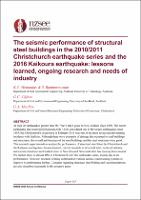| dc.contributor.author | Mohandas, Kiran | |
| dc.contributor.author | Ramhormozian, Shahab | |
| dc.contributor.author | Clifton, G. Charles | |
| dc.contributor.author | MacRae, Gregory Anthony | |
| dc.date.accessioned | 2020-06-18T13:56:06Z | |
| dc.date.available | 2020-06-18T13:56:06Z | |
| dc.date.issued | 2020-04-22 | |
| dc.identifier.uri | https://repo.nzsee.org.nz/xmlui/handle/nzsee/1742 | |
| dc.description.abstract | At least 20 earthquakes greater than Ms 7 have taken place in New Zealand since 1850. The recent earthquake that occurred in Kaikoura (Ms 7.8) is considered one of the largest earthquakes since 1855, but Christchurch's occurrence in February 2011 was one of the most severe and devastating incidents with fatalities. Although there were examples of damage that occurred to steel buildings and structures, the overall performance of the steel buildings and the steel structures were good. This research paper intends to analyze the performance of structural steel from the Christchurch and the Kaikoura earthquakes, lessons learned, current research in structural steel, needs of industry, and current structural steel market share in New Zealand. Structural steel has risen up from around 0% market share to almost 80% in Christchurch after the earthquake series, mainly due to its performance. However, research is being continued on various seismic load resisting systems to improve its performance further. Concerns regarding structural steel bolting and recommendations are also described succinctly in this research paper. | |
| dc.language.iso | en | |
| dc.publisher | New Zealand Society for Earthquake Engineering | |
| dc.relation.ispartofseries | 2020;145 | |
| dc.subject | Advances in earthquake engineering research | |
| dc.title | The seismic performance of structural steel buildings in the 2010/2011 Christchurch Earthquake series and the 2016 Kaikoura earthquake: lessons learned, ongoing research and needs of industry | |
| dc.type | Article | |

